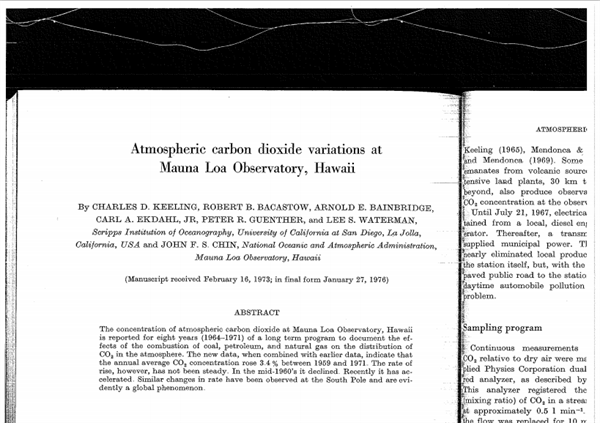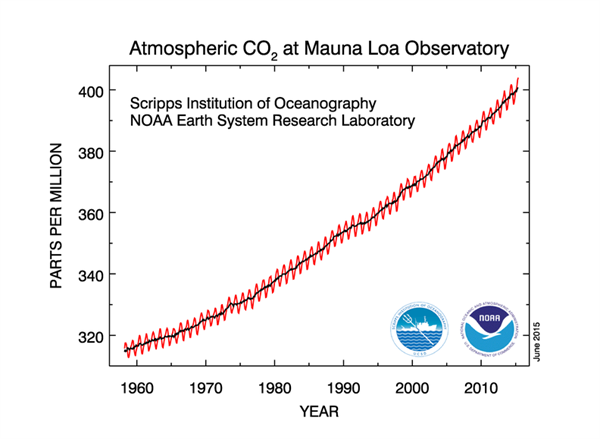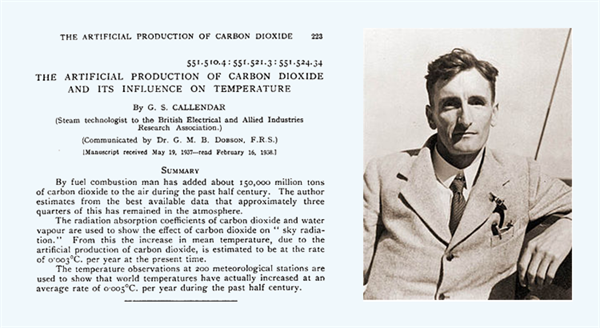Which of the many thousands of papers on climate change published each year in scientific journals are the most successful? Which ones have done the most to advance scientists’ understanding, alter the course of climate change research, or inspire future generations?
On Wednesday, Carbon Brief will reveal the results of our analysis into which scientific papers on the topic of climate change are the most “cited”. That means, how many times other scientists have mentioned them in their own published research. It’s a pretty good measure of how much impact a paper has had in the science world.
But there are other ways to measure influence. Before we reveal the figures on the most-cited research, Carbon Brief has asked climate experts what they think are the most influential papers.
We asked all the coordinating lead authors, lead authors and review editors on the last Intergovernmental Panel on Climate Change (IPCC) report to nominate three papers from any time in history. This is the exact question we posed:
What do you consider to be the three most influential papers in the field of climate change?
As you might expect from a broad mix of physical scientists, economists, social scientists and policy experts, the nominations spanned a range of topics and historical periods, capturing some of the great climate pioneers and the very latest climate economics research.
Here’s a link to our summary of who said what. But one paper clearly takes the top spot.
Winner: Manabe & Wetherald ( 1967)
With eight nominations, a seminal paper by Syukuro Manabe and Richard. T. Wetherald published in the Journal of the Atmospheric Sciences in 1967 tops the Carbon Brief poll as the IPCC scientists’ top choice for the most influential climate change paper of all time.
Entitled, “Thermal Equilibrium of the Atmosphere with a Given Distribution of Relative Humidity”, the work was the first to represent the fundamental elements of the Earth’s climate in a computer model, and to explore what doubling carbon dioxide (CO2) would do to global temperature.
The Manabe & Wetherald paper is considered by many as a pioneering effort in the field of climate modelling, one that effectively opened the door to projecting future climate change. And the value of climate sensitivity is something climate scientists are still grappling with today.
Prof Piers Forster, a physical climate scientist at Leeds University and lead author of the chapter on clouds and aerosols in working group one of the last IPCC report, tells Carbon Brief:
This was really the first physically sound climate model allowing accurate predictions of climate change.
The paper’s findings have stood the test of time amazingly well, Forster says.
Its results are still valid today. Often when I’ve think I’ve done a new bit of work, I found that it had already been included in this paper.
Prof Steve Sherwood, expert in atmospheric climate dynamics at the University of New South Wales and another lead author on the clouds and aerosols chapter, says it’s a tough choice, but Manabe & Wetherald (1967) gets his vote, too. Sherwood tells Carbon Brief:
[The paper was] the first proper computation of global warming and stratospheric cooling from enhanced greenhouse gas concentrations, including atmospheric emission and water-vapour feedback.
Prof Danny Harvey, professor of climate modelling at the University of Toronto and lead author on the buildings chapter in the IPCC’s working group three report on mitigation, emphasises the Manabe & Wetherald paper’s impact on future generations of scientists. He says:
[The paper was] the first to assess the magnitude of the water vapour feedback, and was frequently cited for a good 20 years after it was published.
Tomorrow, Carbon Brief will be publishing an interview with Syukuro Manabe, alongside a special summary by Prof John Mitchell, the Met Office Hadley Centre’s chief scientist from 2002 to 2008 and director of climate science from 2008 to 2010, on why the paper still holds such significance today.
Joint second: Keeling, C.D et al. ( 1976)
Jumping forward a decade, a classic paper by Charles Keeling and colleagues in 1976 came in joint second place in the Carbon Brief survey.
Published in the journal Tellus under the title, “Atmospheric carbon dioxide variations at Mauna Loa observatory,” the paper documented for the first time the stark rise of carbon dioxide in the atmosphere at the Mauna Loa observatory in Hawaii.
Dr Jorge Carrasco, Antarctic climate change researcher at the University of Magallanes in Chile and lead author on the cryosphere chapter in the last IPCC report, tells Carbon Brief why the research underpinning the “Keeling Curve’ was so important.
This paper revealed for the first time the observing increased of the atmospheric CO2 as the result of the combustion of carbon, petroleum and natural gas.
Prof David Stern, energy and environmental economist at the Australian National University and lead author on the Drivers, Trends and Mitigation chapter of the IPCC’s working group three report, also chooses the 1976 Keeling paper, though he notes:
This is a really tough question as there are so many dimensions to the climate problem – natural science, social science, policy etc.
With the Mauna Loa measurements continuing today, the so-called “Keeling curve” is the longest continuous record of carbon dioxide concentration in the world. Its historical significance and striking simplicity has made it one of the most iconic visualisations of climate change.
Also in joint second place: Held, I.M. & Soden, B.J. (2006)
Fast forwarding a few decades, in joint second place comes a paper by Isaac Held and Brian Soden published in the journal Science in 2006.
The paper, “Robust Responses of the Hydrological Cycle to Global Warming”, identified how rainfall from one place to another would be affected by climate change. Prof Sherwood, who nominated this paper as well as the winning one from Manabe and Wetherald, tells Carbon Brief why it represented an important step forward. He says:
[This paper] advanced what is known as the “wet-get-wetter, dry-get-drier” paradigm for precipitation in global warming. This mantra has been widely misunderstood and misapplied, but was the first and perhaps still the only systematic conclusion about regional precipitation and global warming based on robust physical understanding of the atmosphere.
Honourable mentions
Rather than choosing a single paper, quite a few academics in our survey nominated one or more of the Working Group contributions to the last IPCC report. A couple even suggested the Fifth Assessment Report in its entirety, running to several thousands of pages. The original IPCC report, published in 1990, also got mentioned.
It was clear from the results that scientists tended to pick papers related to their own field. For example, Prof Ottmar Edenhofer, chief economist at the Potsdam Institute for Climate Impact Research and co-chair of the IPCC’s Working Group Three report on mitigation, selected four papers from the last 20 years on the economics of climate change costs versus risks, recent emissions trends, the technological feasibility of strong emissions reductions and the nature of international climate cooperation.
Taking a historical perspective, a few more of the early pioneers of climate science featured in our results, too. For example, Svante Arrhenius’ famous 1896 paper on the Greenhouse Effect, entitled “On the influence of carbonic acid in the air upon the temperature of the ground”, received a couple of votes.
Prof Jonathan Wiener, environmental policy expert at Duke University in the US and lead author on the International Cooperation chapter in the IPCC’s working group three report, explains why this paper should be remembered as one of the most influential in climate policy. He says:
[This is the] classic paper showing that rising greenhouse gas concentrations lead to increasing global average surface temperature.
A few decades later, a paper by Guy Callendar in 1938 linked the increase in carbon dioxide concentration over the previous 50 years to rising temperatures. Entitled, “The artificial production of carbon dioxide and its influence on temperature,” the paper marked an important step forward in climate change research, says Andrew Solow, director of the Woods Hole Marine Policy centre and lead author on the detection and attribution of climate impacts chapter in the IPCC’s working group two report. He says:
There is earlier work on the greenhouse effect, but not (to my knowledge) on the connection between increasing levels of CO2 and temperature.
Though it may feature in the climate change literature hall of fame, this paper raises a question about how to define a paper’s influence, says Forster. Rather than being celebrated among his contemporaries, Callendar’s work achieved recognition a long time after it was published. Forster says:
I would loved to have chosen Callendar (1938) as the first attribution paper that changed the world. Unfortunately, the 1938 effort of Callendar was only really recognised afterwards as being a founding publication of the field … The same comment applies to earlier Arrhenius and Tyndall efforts. They were only influential in hindsight.
Other honourable mentions in the Carbon Brief survey of most influential climate papers go to Norman Phillips, whose 1956 paper described the first general circulation model, William Nordhaus’s 1991 paperon the economics of the greenhouse effect, and a paper by Camile Parmesan and Gary Yohe in 2003, considered by many to provide the first formal attribution of climate change impacts on animal and plant species.
Finally, James Hansen’s 2012 paper, “Public perception of climate change and the new climate dice”, was important in highlighting the real-world impacts of climate change, says Prof Andy Challinor, expert in climate change impacts at the University of Leeds and lead author on the food security chapter in the working group two report. He says:
[It] helped with demonstrating the strong links between extreme events this century and climate change. Result: more clarity and less hedging.
Marc Levi, a political scientist at Columbia University and lead author on the IPCC’s human security chapter, makes a wider point, telling Carbon Brief:
The importance is in showing that climate change is observable in the present.
Indeed, attribution of extreme weather continues to be at the forefront of climate science, pushing scientists’ understanding of the climate system and modern technology to their limits.
Look out for more on the latest in attribution research as Carbon Brief reports on the Our Common Futures Under Climate Change conference taking place in Paris this week.
Pinning down which climate science papers most changed the world is difficult, and we suspect climate scientists could argue about this all day. But while the question elicits a range of very personal preferences, stories and characters, one paper has clearly stood the test of time and emerged as the popular choice among today’s climate experts – Manabe and Wetherald, 1967.







